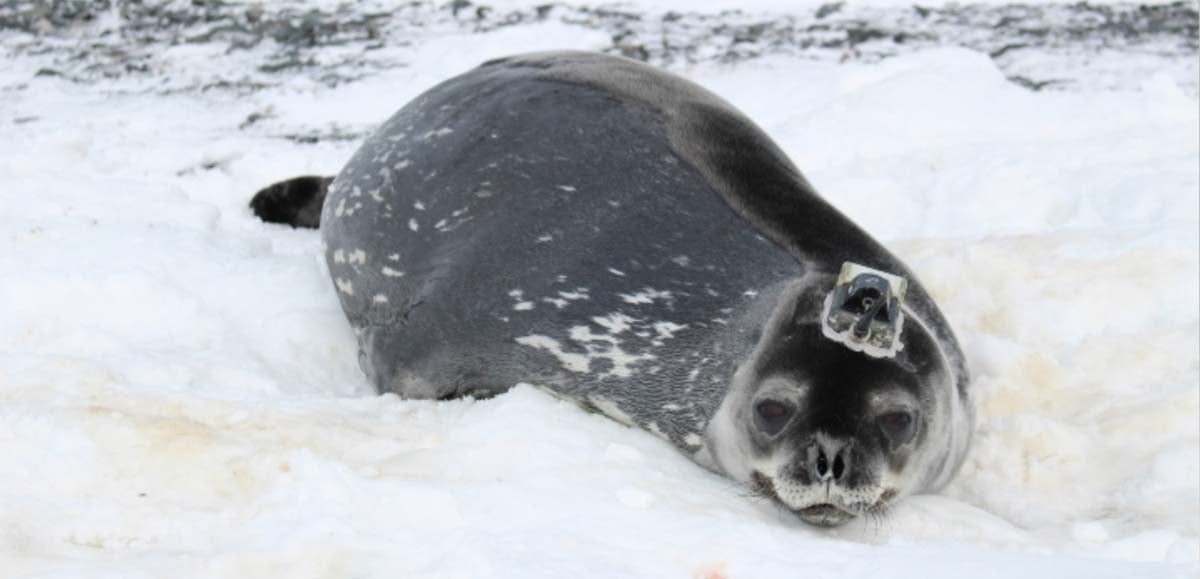March 22, 2021
More Antarctic meltwater is surfacing than was previously known, modifying the climate, preventing sea ice from forming and boosting marine productivity according to new research from the University of East Anglia (UEA), University of Gothenburg and URI Graduate School of Oceanography.
For the first time, researchers have been able to obtain full-depth glacial meltwater observations in winter, using instruments attached to the heads of seals living near the Pine Island Glacier, in the remote Amundsen Sea in the west of Antarctica.
The harsh environmental conditions in the Antarctic limit the use of most traditional observation systems, such as ships and airplanes, especially in winter. But oceanographers working with biologists used data collected by tagged seals to measure water temperature and salinity.
The paper, “Winter seal-based observations reveal glacial meltwater surfacing in the southeastern Amundsen Sea,” is published in the journal Communications: Earth and Environment.
The surfacing meltwater provides near-surface heat that helps to maintain areas of open seawater surrounded by sea ice, close to glaciers, and may change the melting rate of these fragile ice shelves. These findings offer important clues to better predicting the future climate system and sea level rise.
“We know much less about how the ocean affects melting glaciers in winter, as compared with summer, because this region is so challenging to access,” said GSO professor Brice Loose, one of the paper’s co-authors. “The seals are at home in this environment, and the data they have gathered reveals how glacial melt spreads across the surface ocean much more in winter than in summer. This revelation begins to explain some of the impacts seen in sea ice formation, and in ocean overturning circulation, which affect future climate”
Pine Island Glacier is rapidly melting, exporting the glacial meltwater into the ocean. Glacial meltwater is thought to play a role in hydrography and sea ice distribution, but until now little has been known about it.
“The temperature and salinity of water change everywhere glacial meltwater exists,” said Yixi Zheng, a postgraduate researcher in UEA’s School of Environmental Sciences and lead author of the study. “Just like looking for a ‘fingerprint’ of glacial meltwater, we use temperature and salinity data to track the glacial meltwater.
“As the glacial meltwater is warmer and fresher than the ambient water, it is lighter than the ambient water and more likely to rise up. It brings heat and nutrients such as iron to the near surface, which may melt the sea ice near glaciers and increase the nutrient level near the surface. This enhances the air-sea interactions, and the meltwater-related nutrient may boost the growth of marine planktons like algae.”
The winter processes revealed by the study are likely important for bringing nutrients to the near-surface layer prior to the spring bloom, and for bringing heat to the surface to prevent sea ice from forming. This action helps to maintain the open water areas, called polynyas, in front of glaciers.
Many glaciers around Antarctica are thinning rapidly, due primarily to basal melting (i.e. melting that occurs at the interface between the ocean and the ice shelf glacier). The strongest melt has been reported in west Antarctic glaciers such as the Pine Island Glacier, where the research took place.
The volume of meltwater produced is small in comparison with the volumes of Antarctic shelf seas, but it is believed to exert a disproportionate influence on regional circulation and climate.
The heat from the meltwater is likely to prevent sea ice formation, allowing melting of sea ice and thus increasing the extent of open water areas in front of glaciers.
The strong offshore wind near the glacier front may also transport warm near-surface water further and expand the meltwater-influenced region. These enlarged polynyas (open-water areas surrounded by ice) can then lead to enhanced air-sea fluxes and have further impacts on iceberg calving and glacier melting.
Seven southern elephant seals (Mirounga leonina) and seven Weddell seals (Leptonychotes weddellii) were captured and tagged with CTD-Satellite Relayed Data Loggers around the Amundsen Sea in February 2014. The data were gathered by Marine Mammals Exploring the Oceans Pole to Pole (MEOP).
The scientists say further research is required. The study was based on one year of seal-tag data from the Pine Island Glacier, so it can’t be used to calculate trends over time or take into account interannual variability such as the El Nino-Southern Oscillation, which may affect the global water temperature.

